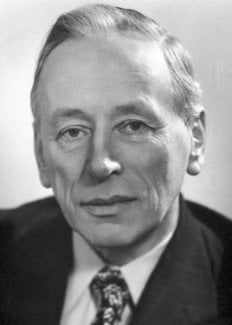Frits Zernike
Biographical

Frits Zernike was born in Amsterdam, 16th July 1888, as the second son in a family of six children. His father, Carl Frederick August Zernike, was teacher in mathematics and head of a primary school in Amsterdam, and was a highly gifted man having interests in many branches of science; he compiled numerous elementary books in a series of subjects, and had also articles on pedagogy to his credit. His mother, Antje Dieperink, was also a teacher of mathematics. One of his brothers also became a professor of physics, one of his sisters, married to the well-known painter Jan Mankes, was the first woman ordained in the Dutch Protestant Church, another sister is one of The Netherlands’ foremost literary figures.
Frits inherited his passion for physics from his father; as a boy he already possessed an arsenal of pots, crucibles, tubes, which he scraped together with his own pocket money, or received as gifts from understanding manufacturers. At the secondary school he excelled in the scientific subjects, and neglected topics such as history and languages, including Greek and Latin, for which later on he was obliged to pass a State matriculation test in order to be fully admitted to the University.
During these school years he devoted all his spare time to his endless experiments, entering also the realms of colour photography. His limited financial means forced him to synthesize his own ether which he required for his photographic experiments. Other results of his ingenuity were a photographic camera and a miniature astronomical observatory equipped with the clockwork of an old record player, which enabled him to take pictures of a comet. Together with his father and mother he also indulged in solving arduous mathematical problems.
He entered the University of Amsterdam in 1905, studying chemistry, with physics and mathematics as minor subjects. His early interest in mathematics appears from a prize essay on probabilities for which he obtained a gold medal of the University of Groningen in 1908. A more elaborate work on critical opalescence was similarly rewarded in 1912 by the Dutch Society of Sciences at Haarlem, which had as jury distinguished scientists of those days: Lorentz, Van der Waals, and Haga. When asked to choose between a gold medal and an amount of money, he wrote back that he preferred the money, since he had already enjoyed the privilege of receiving a gold medal. The prize essay later formed the basis of his doctor’s thesis (1915). In its theoretical part he applied Gibbs’ statistical mechanics and this formed the starting-point of years of fruitful collaboration with L.S. Ornstein, who worked in the same field.
In 1913 Kapteyn, the famous Professor of Astronomy at Groningen University, invited him to be his assistant. In 1915 he got his first university teaching post, not in chemistry, not in astronomy, but as successor of Ornstein as lecturer in mathematical physics at Groningen, where he was made a full professor in 1920. His papers on statistics include a paper with J.A. Prins, introducing the g-function for the correlation of the position of two molecules in a liquid, an extensive article in the Geiger and Scheel handbook, and an approximation method in the order-disorder problem (1940). Of his experimental work, the sensitive galvanometer, manufactured since 1923 by Kipp and Sons, Delft, is well known. From 1930 on he turned to optics, developed phase contrast, wrote on imaging errors of the concave grating and on partial coherence. With the collaboration of his pupils he solved the problem of the influence of lens aberrations on the diffraction pattern at a focus (1938-1948)
It is interesting to know that his great discovery of the phase-contrast phenomenon, which he discovered one evening in 1930 in his totally blackpainted optical laboratory, did not immediately receive the attention it deserved. The world-famous Zeiss factories at Jena completely underestimated the value of his phase-contrast microscope. It was not until the German Wehrmacht took stock of all inventions which might serve in the war that at last (in 1941) the first phase-contrast microscopes were manufactured. The grotesque situation thus arose that the German war machinery helped to develop on an industrial scale Professor Zernike’s long-neglected invention while its inventor, like his fellow-countrymen, suffered under the oppression by the same German powers during the occupation of the Netherlands. After the war, other firms also took up the production of many thousands of phase-contrast microscopes, thereby providing the service to science, and in particular to medicine, which should have been effectuated some twenty years earlier.
Zernike’s achievements were recognized by the Royal Microscopical Society; he was also awarded the Rumford Medal of the Royal Society (London) and an honorary doctorate in Medicine from the University of Amsterdam.
Zernike married twice. His first wife, Dora van Bommel van Vloten, died in 1945; they had one son. In 1954 he married Mrs. L. Koperberg-Baanders. After his retirement from Groningen University they moved to Naarden, a town in the countryside near Amsterdam.
This autobiography/biography was written at the time of the award and first published in the book series Les Prix Nobel. It was later edited and republished in Nobel Lectures. To cite this document, always state the source as shown above.
Frits Zernike died on March 10, 1966.
Nobel Prizes and laureates
Six prizes were awarded for achievements that have conferred the greatest benefit to humankind. The 14 laureates' work and discoveries range from quantum tunnelling to promoting democratic rights.
See them all presented here.
